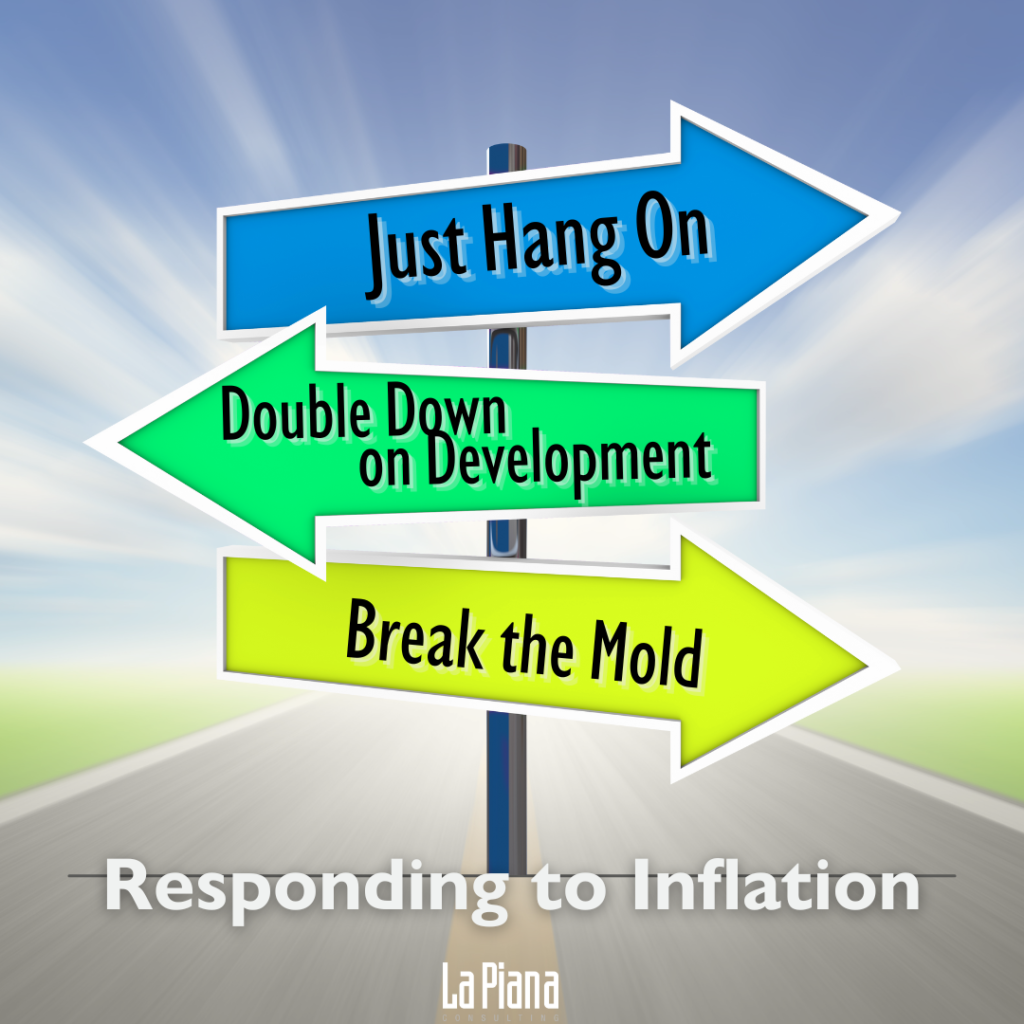Coping with Inflation
Key Points
- High inflation is a periodic, recurring problem – we’ve been here before
- How you respond to any financial crisis depends on your analysis of the cause
- Is this a short-term (6-18) month challenge, a longer-term or persistent challenge, or has it revealed a more fundamental weakness in your business model?
Past and Present Inflation
Our recent survey of nonprofit leaders confirmed what we suspected: people are worried about the impact of inflation and the possibility of a recession, and with good reason.
U.S. inflation peaked last summer at an annual rate of 9.1%. That means buying normal things people need – rent, food, gas, diapers – cost 9% more than a year earlier. That’s a huge price increase and it hurts everyone, but it is especially destabilizing for people with the most limited means. That includes those among us with little to no savings, people who work low-wage jobs with few benefits, and those who were already experiencing income, food, and housing insecurity.
The slightly better news is that by January 2023 the annual inflation rate had dropped to 6.4%. That’s better but still far above what we have grown used to over the last decade, when prices remained relatively stable, with inflation ranging from 0%-2% from 2012-2021.
We’ve been here before. After the 2008 financial crisis, inflation approached 6%. For an even longer perspective, I began my nonprofit career in 1980 (I know, I know!). Inflation topped 14%, unemployment soared to historic highs, and the economy stagnated. In my home state of California, the pain was compounded by Proposition 13, passed in 1978, which decimated the state’s budget and future ability to raise taxes. On a personal note, this led to my being laid off from not one but two low-wage social service jobs in the space of 3 months, and I was far from alone.
Responding to Inflation
What have we learned from past bouts of high inflation, and what can we do about it today? As a nonprofit leader, how should you respond to this new but not unprecedented phenomenon of steadily increasing prices, with no clear end in sight? The pressures are clear. Your staff are hurting. Your vendors, landlord, and contractors are raising their rates because they too are hurting. Prices spiral because costs spiral because prices spiral. . .
First, take a breath and recognize that in the short term, there is little any of us can do individually about the economy. Yes, we advocate for better policies, a stronger social safety net, better jobs and worker protections, and a more equitable economy overall, but those are aspirational goals. While we work for justice, we need strategies for keeping our organizations healthy and on track today.
Remember also that the purpose of any nonprofit is to advance and ultimately achieve its mission. All our decisions should prioritize those ends, doing so in alignment with your values. Sometimes, difficult short-term decisions are needed to get us there, whether it be trimming a beloved but unsustainable program, dipping into a rainy day fund, or tightening spending in other ways.
The last few years have seen record fundraising by many social justice groups in the wake of George Floyd’s murder and the emergence of Mackenzie Scott and other new mega-donors. If your organization experienced this recent growth in fundraising, congratulations! As a result, you may have created or added to a reserve. Most of us view the reserve as sacrosanct, funds held as a bulwark against “a rainy day.” While I would not counsel spending down reserves to avoid difficult decisions, if a portion of these funds is committed wisely, it can provide critical bridging support to a secure future.
In responding to inflationary – or other – financial pressures, you can choose from among three paths, reflecting three different theories about the nature of the problem. Stated briefly, those paths are:

Let’s take these in turn.
Just Hang On
If a financial challenge is likely short-term, due to an identifiable cause, such as a large one-time expense, or a shift in your work that promises support in 6-18 months, it may be wise to invest some reserves (if you have them), use a line of credit, delay planned expenses such as a tech upgrade, consider temporary salary reductions (focusing on the highest-paid staff), or take other bridging steps that enable you to keep the organization whole, avoid the trauma of layoffs, and remain ready to resume efforts in a few months. Beware here the possibility of convincing yourself a problem is short term when it is not. A cash shortage may be short-term, but high inflation is generally not.
Double Down on Development
If a financial challenge, such as high inflation, is likely to persist, the first thought of many leaders – to the frustration of their development directors – is to increase fundraising efforts. Prices rise, so you respond by raising more money. Problem solved – maybe. Generally, to increase fundraising receipts, you must first increase your investment in the function. Additional staff, systems, and cultivation efforts cost money, and take time to bear fruit. Moreover, if your financial challenge comes because foundations have moved on from your issue or the economy is in a prolonged slump, even this investment may not pay off.
Break the Mold
Sometimes, a significant long-term financial challenge such as persistent inflation reveals a more fundamental problem: your business model can no longer be relied upon to provide adequate resources for operations. A business model is a combination of what your organization does, where it does it, who it benefits, and how it pays for it. One or more of those elements can change over time, causing the entire system to fail. In good economic times, this shift can remain hidden from view, but when the economy weakens or inflation soars, it is suddenly evident. The solution here is to adjust one or more of those basic building blocks of your business model. For example, to widen your geographic scope or narrow the range of issues you work on, or to move beyond a reliance on foundations to add individual giving. Finding the answer can be a complex process, but identifying the question is the necessary first step.
The Bottom Line
To successfully address inflation you must first understand the level of challenge rapidly increasing costs presents for your organization and whether your business model can respond. With the right diagnosis of the cause and likely duration of the challenge, you can take the necessary steps to keep your organization strong. As Einstein said, “If I were given one hour to save the planet, I would spend 59 minutes defining the problem and one minute resolving it.” So, pull your team together to consider the nature and likely duration of the challenges inflation poses to your organization and your current business model’s resilience in the face of those stresses. Then work to create a response.


Comment section
1 thought on “Coping with Inflation”